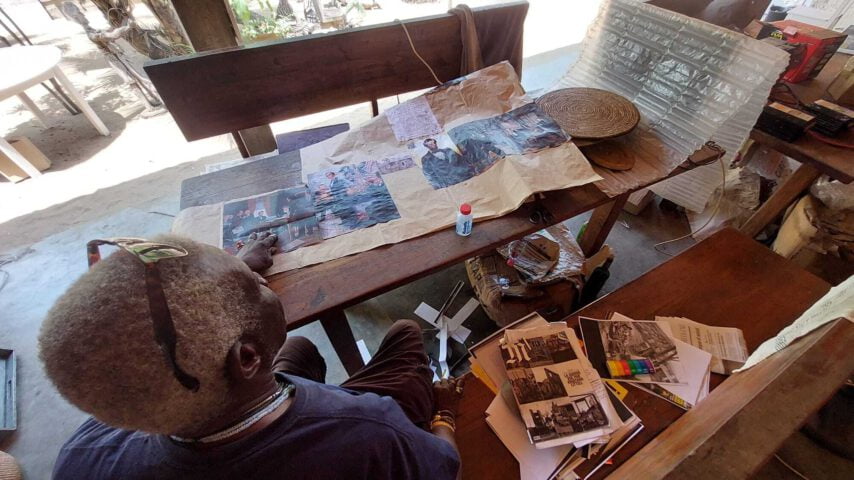Transforming a Historic DC Home into a Work of Global Art
Acclaimed African artist Georges Adéagbo will install his assemblage art at President Lincoln’s Cottage in January
Images by Stephan Köhler

Award-winning artist Georges Adéagbo (born 1942 in Cotonou, Benin), known worldwide for his found-object installations, will be making a rare appearance in the US this winter. He will be exploring themes of freedom and bondage at President Lincoln’s Cottage, the home where Abraham Lincoln lived and developed the Emancipation Proclamation. “We are thrilled to be collaborating with the Smithsonian’s National Museum of African Art to share the groundbreaking work of Georges Adéagbo with new audiences,” said Michael Atwood Mason, CEO & Executive Director of President Lincoln’s Cottage. “In addition to its aesthetic value, the exhibit will contribute to a deepening and evolving understanding of Abraham Lincoln’s place in the world’s imagination.”
In vignettes throughout the Cottage comprising sculpture, craft assemblages, found objects, and handcrafted illustrations and signage, this month-long exhibition, Create to Free Yourselves: Abraham Lincoln and the History of Freeing Slaves in America, will honor Adéagbo’s lifelong interest in President Lincoln. Adéagbo described Lincoln as, “the man who above all cared about reforging the union, not by force and repression, but by the warmth of his feelings and the generosity of his heart.” Glimpses of this generous-hearted Lincoln will be on display alongside those of the shrewd politician. “Adéagbo is concerned with the relationship between the personal and the political, and President Lincoln’s Cottage is a rare place where Lincoln’s private and professional lives intersect. It is the perfect place to showcase his work,” said Mason.
Intercultural transfer will also be at the heart of the exhibit. The objects in the exhibition are prepared by a team of artists in Benin and will be assembled at President Lincoln’s Cottage. The objects are relational in nature, interacting with one another, with their creators in Benin, with Abraham Lincoln and the history of slavery, and with the historic structure itself. This intersection of relationships will be the fertile ground for Adéagbo’s unique messaging, and the process becomes an act of artistic self-liberation.
“Georges Adéagbo is one of the most significant artists alive today. We cannot wait to see his transformative visual storytelling at work at President Lincoln’s Cottage and are delighted to be a part of the project,” said Karen E. Milbourne, Senior Curator at the National Museum of African Art.
The installation process will begin in the New Year, following the anniversary of the day Lincoln’s Emancipation Proclamation took effect: January 1, 1863. Graduate students from Howard University’s Chadwick A. Boseman College of Fine Arts will be assisting Adéagbo with the installation. “We are pleased to partner with Howard to offer a number of passionate, talented art students the chance to work closely with such an important figure in the global art world,” said Mason.
The exhibit will open January 17th and run through February 15th. Opportunities to meet the artist and see the installation in progress may be granted to the press upon request prior to opening.
President Lincoln’s Cottage is located on the grounds of the Armed Forces Retirement Home in Washington, DC. While living here for more than a quarter of his presidency, Abraham Lincoln bonded with soldiers and veterans, made crucial.
decisions about the Civil War, and developed the Emancipation Proclamation. His daily commute put him in regular contact with wounded soldiers and self-emancipated men, women, and children which altered his understanding of the country and the war. Today, the site offers an intimate view of Abraham Lincoln’s presidency and private life, and new perspectives on the influential ideas Lincoln developed while living here. Hours of operation: the site is open 362 days a year between the hours of 9:30am and 4:30pm with guided tours on the hour. For more information on President Lincoln’s Cottage, visit: www.lincolncottage.org and follow along on social media @lincolnscottage.
The Smithsonian’s National Museum of African Art is part of the Smithsonian with a mission to be a 21st-century global African art museum. The museum’s collection of primarily visual arts span across the continent from the 11th century until today. As part of an ongoing and radical revisioning, the museum now also provides dynamic and collaborative art experiences in locations across the continent and throughout global African spaces to nurture regenerative art ecosystems.
Contact: Rebecca Kilborne
240-997-6223

